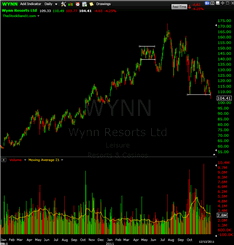Trading Timeframe Influences Position Size
 Equally important to locating entries and exits is the matter of sizing your positions. Too much and you can’t stick with the trade plan, aborting in favor of diminishing emotions (whether greed or fear). Too little and you don’t maximize the use of your capital.
Equally important to locating entries and exits is the matter of sizing your positions. Too much and you can’t stick with the trade plan, aborting in favor of diminishing emotions (whether greed or fear). Too little and you don’t maximize the use of your capital.
While some traders prefer a standard lot size, in this video I’ll discuss the notion that your timeframe for the trade should influence your position size.
Yes, the chart itself will help determine your exits, but that’s also a function of how long you’ll expect to be in the trade.
Check out the video for a quick 5-minute explanation and you’ll see exactly what I mean.
(Direct video link is here for those interested in sharing).
Be sure to view in HD (720P) and full-screen mode for best quality in the video.
Trade Like a Bandit!
Jeff White
Producer of The Bandit Broadcast
Follow TheStockBandit on Twitter or get our free newsletter to keep up!







Arthuredayjr | Dec 14, 2011 | Reply
This is another video of great value. As I have become a day trader for a year now, I have to have this mindset. Depending on capital every trade is important BUT if it goes in the wrong direction IF you do not get out right away you have funds tied up. I have missed some big runs in MSO, LF, and now PSUN because I got out too early. It is frustrating as well to stay in too long and get locked in.
Knowing in advance what timeframe you are trading in is essential. What are you willing to risk and for how long. I love these training videos and they help me. I had been sizing all my entries at 250 shares (I trade stocks between 1 and 5 dollars so I can get more shares). And then if it goes against me I average down which is like throwing more bad money on bad money. I don’t go back far enough to look in the past to see potential of long trades because I spook out in fear on pullbacks. With help like this from Jeff, it makes us all better smarter traders. What is my plan when I enter a trade?
Anonymous | Dec 14, 2011 | Reply
I agree Art, averaging down is not the way a professional averages in….they add when the trade is confirming that it’s working, and if they do it when the trade is against them it’s all according to plan and not a disruption of discipline. Thanks for your comments!
Anonymous | Dec 30, 2011 | Reply
Really very useful & informative post.
Anonymous | Jan 1, 2012 | Reply
Glad you enjoyed it, thanks for reading!
Vivek | Dec 18, 2013 | Reply
Hi Jeff,
Assuming your edge exists on a 5 min timeframe, how do you continue to trade larger lots as your account size increases? Won’t slippage hurt much more? Do you cap your position size per time frame? eg: not more than 3 lots on 5 min etc?
TheStockBandit | Dec 19, 2013 | Reply
Hi Vivek,
Scaling up your size is going to always be tied to just how liquid the stock or instrument is that you’re trading. If it’s thin enough to move price, then yes slippage will hurt more. If instead you’re trading liquid stocks, the effect should be minimal.
Thanks for reading,
Jeff